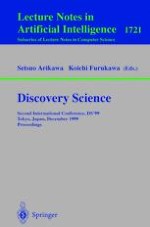1999 | Buch
Discovery Science
Second International Conference, DS’99 Tokyo, Japan, December 6–8, 1999 Proceedings
herausgegeben von: Setsuo Arikawa, Koichi Furukawa
Verlag: Springer Berlin Heidelberg
Buchreihe : Lecture Notes in Computer Science
Enthalten in: Professional Book Archive
